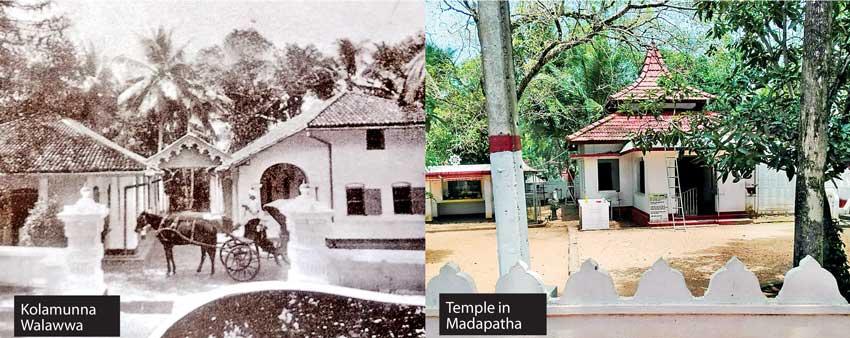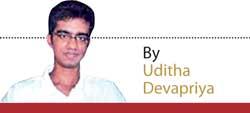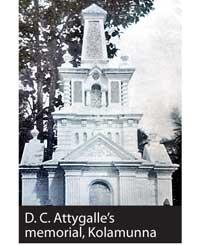Reply To:
Name - Reply Comment
Last Updated : 2024-04-19 20:44:00

 Every morning at 5.20, I wake up to the sound of distant drums followed by the chanting of pirith. I literally begin my day with a reminder of the impermanence of life. But then dawn breaks 10 minutes later, and by 5.45, what with the tooting of horns and the chirping of birds heralding the coming day, I can no longer hear the pirith as clearly.
Every morning at 5.20, I wake up to the sound of distant drums followed by the chanting of pirith. I literally begin my day with a reminder of the impermanence of life. But then dawn breaks 10 minutes later, and by 5.45, what with the tooting of horns and the chirping of birds heralding the coming day, I can no longer hear the pirith as clearly.
At this point I get ready for the day ahead: washing up, getting dressed, eating breakfast, and leaving home to catch my van. I meet the same people on the road, waiting for the same vans and buses, wearing something different perhaps, but preparing themselves to go through the same routines. By now pirith is over; the loudspeakers start to preach other, more secular things. The day has officially begun.

At 6.15, the sun is up. What little romanticism there was in the early hours, when not a soul could be heard and only the faintest light could be seen far, far away, has evaporated. An unbearable lightness of being creeps up in me then: after all, there’s nothing like the early hours to shield you from the burdens of the hours to come.
Madapatha is not a particularly fascinating village. It’s not even a village. Like so many suburbs outside Colombo city and within Colombo district, it tries to emulate the metropolis and fails spectacularly. Madapatha is in Piliyandala, and Piliyandala is growing; recently the government opened a new bus depot, which looks so well furnished it invites comparisons with the Matara bus depot and which leads to a bypass connecting Kesbewa to the Colombo road via Wewala, opened by the then president on his birthday in 2014; days, as it turned out, before his health minister made a crucial defection.

When I moved here 15 years ago, the roads were narrower, the wastelands bigger, the population sparser. It’s amazing what 15 years can do. The roads have expanded, and the wastelands, drained by property developers, are no more.
It’s also amazing what 15 years can’t do. The population has grown, yet as far as this part of the decade is concerned they remain the same people I’ve seen, talked to, and been with for as long as I can remember. They still talk with the same salty chattiness. They still gossip. And they still show their concern for those around them.
Sometimes that concern for who you are and how you’re doing can overreach itself. I was 10 when I moved in, and I remember the first thing my neighbour told me: “You can’t see clearly, can you?” Touching, yet intrusive. I was wearing spectacles, as I still am, but more important was the fact that in our lane not a single child had them.
As the years passed the changes kept on coming. Like the walls. Earlier no house in our neighbourhood, except for one or two of the affluent middle class ones, had them. Then civilisation moved in and the neighbours thought it better to erect them; they had property disputes. Sri Lankans love their land. As civilisation grows, they need to show others that they love their land. So they start building walls. Not the fortifications and ramparts you see in Colombo and its suburbs, but less higher, certainly less majestic.

The areas around where I live aren’t too different. They have changed in the same way: more houses and walls, more outsiders coming in, more resorts and restaurants coming up, and more expensive property. When we arrived here, land prices hovered near Rs. 30,000 a perch; back then a perch in Ethul Kotte, from where we moved, fetched up to 10 times as much. Today a perch here can cost you up to LKR 700,000, while in Ethul Kotte it would fetch around LKR 2.5 million. Property has become lucrative relative to other suburbs; that has a lot to do with the widening of the Colombo-Horana road and the role Piliyandala continues to play as a link between Colombo and Kalutara.
Piliyandala, of course, belongs to Kesbewa, and not the other way around as is sometimes assumed. At the turn of the 20th century Kesbewa, which belonged to the Palle Pattuwa, in turn a part of Salpiti Korale, included 16 villages: Suwarapola, Wewala, Hedigama, Deltara, Batakettara, Dampe, Makandana, Niwungama, Halpita, Horetuduwa, Konduruwewa, Demaladuwa, Moraenda, Berawawala, Kolamunna, and Madapatha. Hedigama and Deltara bordered on Panadura to the north, while Makandana and Madapatha bordered on Bandaragama to the south: the two frontiers of the Kalutara district.
By 1901 much of the local population had settled in Batakettara, Demaladuwa, Makandana, Deltara, and Madapatha; the number of occupied houses in Madapatha then (80) was about half that in Batakettara (144), the most densely populated region, while the population (532) trailed behind Demaladuwa (717) and Makandana (671). 10 years later the place had grown: the number of houses to 109 and the population to 600.
The rise of these locales paralleled the rise of the bourgeoisie. Madapatha, after all, was the home of the Attygalles, whose fortunes were in graphite, while Kolamunna two kilometres away became D. C. Attygalle’s final resting place, the site of his sohona: a sacrosanct space violated by schoolboys playing cricket and volleyball next door.
In fact Madapatha bears the unmistakeable signature of the Attygalles. But they almost hardly seem to make the waves they once did. The old graphite or plumbago industry is, of course, no more. The old rich have either migrated elsewhere, or given way to the new rich while maintaining their grip on politics. Even there, the old has had to give way to the new; none of the local MPs from either of the two main parties can claim a direct relationship to the old Madapatha Attygalle-Kotelawala cartel.
Still, the institutions the latter built are there, just as those built by the de Soysas and the Diases are there in Moratuwa and Panadura. And those institutions continue to come up. Right opposite the Kolamunna sohona and right next to the Kolamunna Viharaya, for instance, is a particularly large hospital; reportedly built by an Attygalle, it looks impressive and inviting, yet remains unused and forbidding.
Over time the area from Deltara and Hedigama in the north to Madapatha in the south turned into a suburban tourist belt, mainly because these areas happened to be located near if not adjacent to a wetland sanctuary: Bolgoda.
Environmentalist, birdwatcher, and raconteur Jagath Gunawardena tells me of the time he first visited there, long before civilisation and modernity with all their cosmetic trappings moved in. “The area,” he says, “became a haven for many of those who wanted to retire from Colombo.” Among the many who migrated was J. R. Jayewardene’s son, Ravi; he was adamant on building a new home next to Bolgoda. That house, where he lived as a refugee, soon transformed into “a refuge for resident and migratory birds.”
In fact Madapatha bears the unmistakeable signature of the Attygalles. But they almost hardly seem to make the waves they once did. The old graphite or plumbago industry is, of course, no more
It wasn’t just politicians, civil servants, and their children of course. Artists also began to move in. They preferred the Bolgoda belt, and many of them, like Sunil Ariyaratne, made the belt their second home, building their sanctums next to the lake.
Ariyaratne resides here as a poet lives in his retreat. Even when the landscapes around those retreats seem to be giving way to the new suburbs, the likes of him have made time stand still over where they live. It isn’t paradise, but for them it comes close. In Ariyaratne’s case, the retreat has, I think, captured something of that quaintness, that innocent, childlike simplicity, which comes up in his best work. His muse, the great Nanda Malini, also lived – and lives, I believe – in the vicinity; one person from long ago remembers seeing her in the 1990s, driving through my road Jambureliya “in her little Fiat car.”
Once you factor in its people and its suburbs, its association with the rise of the bourgeoisie, and its status as a retreat for artistes, what else do you get?
Nothing much, to be honest. Tourism has made inroads here, but apart from hotels used more as one night stands than actual hotels, its beauty has missed the unwary traveller. Sure, there’s much to see in terms of history and nature, and you tend to go through the same rites people elsewhere do. And yet people elsewhere have more things to be intrigued by than anything this locale can offer them. But then Madapatha does offer something. Inspiration. You don’t get a whole lot of that in too many places now, do you?
UDAKDEV1@GMAIL.COM

Add comment
Comments will be edited (grammar, spelling and slang) and authorized at the discretion of Daily Mirror online. The website also has the right not to publish selected comments.
Reply To:
Name - Reply Comment
On March 26, a couple arriving from Thailand was arrested with 88 live animal
According to villagers from Naula-Moragolla out of 105 families 80 can afford
Is the situation in Sri Lanka so grim that locals harbour hope that they coul
A recent post on social media revealed that three purple-faced langurs near t